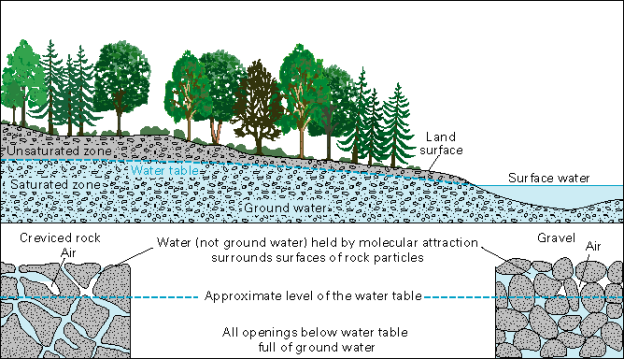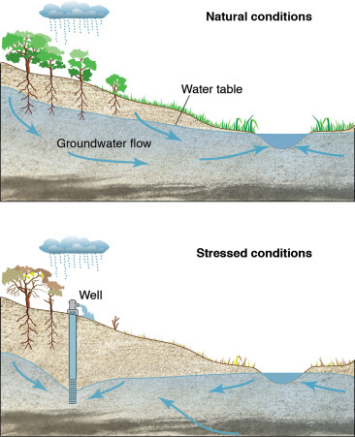Federal Reserved Water Rights and Groundwater: Quantity, Quality, and Pore Space
Tribal rights to groundwater have not been legally established to the same extent as rights to other natural resources (e.g., surface water, timber, minerals). A March 2017 decision of the U.S. Court of Appeals for the Ninth Circuit upheld the rights of a California Indian tribe (the Agua Caliente band of Cahuilla Indians) to groundwater beneath the tribe's reservation in the Coachella Valley. In November 2017, the U.S. Supreme Court declined to review the decision; the case now proceeds to other phases that may partially shape this ruling's significance.
This is the first case in which an appellate court has held that a tribe's "reserved" rights under the Winters doctrine apply to groundwater. Pursuant to Winters, when Congress reserves land for a reservation, it also reserves a right to water necessary to accomplish the purposes for which the reservation was created. For decades, tribal reserved rights for surface water have been established and have required settlements between the federal government (as authorized by Congress), tribes, and nonfederal users. Thus, some have raised concerns about the implications of interpreting Winters rights to include groundwater.
This Insight explores three aspects of groundwater relevant to Agua Caliente: quantity, quality, and "pore space." The legal outcome may affect how groundwater is allocated among tribal and nontribal interests and may influence groundwater allocations at other federal reservations.
The Supreme Court has not declared outright that groundwater is subject to the Winters doctrine, but declining to review the Ninth Circuit decision essentially upheld phase one of the three-phase case: a federally reserved right to the groundwater resource for the tribe. Phase two will address whether the tribe has the right to receive groundwater of a certain quality from the aquifer and whether it owns the pore space beneath tribal lands. Phase three will determine the quantity of groundwater to which the tribe is entitled, pursuant to its reserved rights. The outcome of phases two and three could have implications for expanding the scope of federal preemption of state water law. It also could affect how much groundwater is available for nontribal water agencies and water districts and those entities' ability to store water in an aquifer beneath federally reserved lands. Congress has authority over federal water law and could influence this legal framework.
An aquifer is composed of (1) solid materials, such as rocks and mineral grains; (2) interconnected spaces or openings (pore space); and (3) groundwater, which fills the pore space (Figure 1). In the Coachella Valley aquifers, the amount of groundwater pumped out exceeds the amount of recharge, creating groundwater overdraft conditions (Figure 2). To address the shortfall, local water agencies add water from the Colorado River to recharge the aquifer.
 |
|
Source: U.S. Geological Survey, the USGS Water Science School, at https://water.usgs.gov/edu/earthgwaquifer.html. Notes: The figure shows two examples of pore space. |
|
Figure 2. Aquifer Without Pumping (top) and With Pumping (bottom) |
 |
|
Source: Steven M. Gorelick and Chunmiao Zheng, Global Change and the Groundwater Management Challenge (with permission). Notes: Stressed conditions illustrate overdraft discussed in the text. |
Phase two of the litigation will consider questions of water quality and pore-space ownership. The tribe alleges that groundwater pumping by two water agencies (Desert Water Agency and the Coachella Valley Water District, defendants in this case) has created groundwater overdraft conditions (stressed conditions in Figure 2). Further, the tribe alleges that Colorado River water—used to recharge the aquifer—is of inferior quality. After having decided the tribe has a reserved right to groundwater, the court will consider whether the tribe has a right to water of a certain quality (i.e., of better quality than the currently imported water) and whether the tribe "owns" the pore space (and thus restricts its use).
The question of pore-space ownership in an aquifer may have implications for other Indian tribes and federal reservations where state water law typically guides groundwater management. Local water agencies that have accessed groundwater underlying federal reservations may face challenges to that access and possible restrictions on efforts to artificially recharge aquifers using water from a different source, such as a river. Pore-space ownership issues typically have arisen in the contexts of oil and gas extraction (ownership of the mineral estate), natural gas storage, or carbon dioxide storage, not groundwater.
States generally do not assign ownership of groundwater or pore space; instead, the rights to use groundwater (usufructuary rights within the public trust doctrine) have been developed by law, permit, or legal decisions. "Ownership" of groundwater typically rests with the state as a trustee for the public's benefit, with no regard for the pore space. A decision favoring pore-space ownership by the Agua Caliente band might restrict nontribal entities' use of the aquifer.
How much water the tribe could have rights to—the question of quantity in phase three of the litigation—likely hinges on what the court determines are the reservation's purposes. Currently, the tribe purchases water from local water agencies (the defendants) to help meet its needs (i.e., it does not pump its own groundwater). A quantification of tribal groundwater need exceeding its current use may mean that the local water agencies would have to find other means of meeting supply obligations to nontribal customers (assuming the tribe uses this hypothetical allocation). It also could mean higher costs to the water agencies, if the tribe accepts payment for use of its groundwater allocation. Depending on the future rulings and precedent set by the Agua Caliente case, other areas might face similar trade-offs.
Some in Congress have expressed interest in limiting the application of federal reserved groundwater rights in recent legislation (e.g., S. 1230, H.R. 2939). Some have posed that, if enacted, provisions in these bills might in some cases be interpreted so as to limit the future application of reserved water rights to groundwater, including tribal groundwater rights.